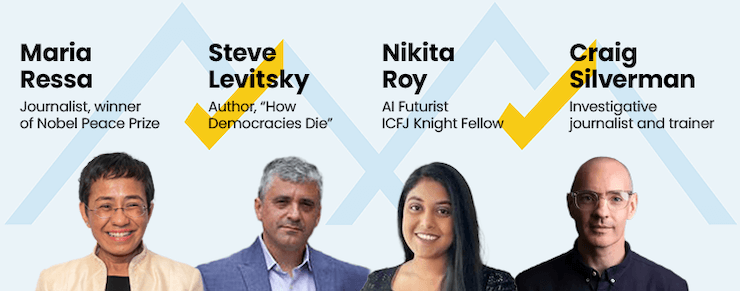CAMBRIDGE, Mass. — High-quality journalism can survive by using, not fearing, new information technology.
Several speakers reiterated that contention at Harvard’s “The Future of News” conference last weekend during a celebration of the 20th anniversary of the university’s Joan Shorenstein Center on the Press, Politics and Public Policy.
“Technology is [just] a tool. It’s the content, stupid,” said Martin Nisenholtz, The New York Times Company’s senior vice president for digital operations. “We use technology to create content in new ways,” he added, citing The New York Times’ coverage of the Oct. 10 plane crash in Manhattan. With the ability to edit news as it happens, driven largely by feeds from eyewitnesses, the paper’s Web site displayed constant updates and — within two hours — a graphic showing the plane’s flight pattern.
“We use the web as leverage to take content all over the world,” Nizenholtz said. “The blogosphere is a huge distribution channel for us.”
And you don’t have to be as big as The Times Company to use similar tactics.
“Every [news] organization can create a unique, distinct database with a world audience,” said Bill Kovach, former editor of The Atlanta Journal-Constitution and founding chairman of the Committee of Concerned Journalists. “We work with local organizations to migrate to new technology with their values intact.”
As an example, he said The Hannibal Courier Post, a 12,000 circulation daily in Missouri, has become the world’s largest repository of information on Mark Twain, a former resident of the town. The newspaper’s Web site offers message boards, access for handheld devices and a collection of online archives.
Whatever the technology, Newsweek assistant managing editor Evan Thomas said “the eternal demand for good stories will never go away” and advertisers will pay for quality news products. And how good are the stories news organizations are producing today? According to Thomas, “There has been some liberal bias in the mainstream media” but added that “media organizations are becoming more careful about showing bias, [which] is healthy.”
Thomas said his biggest challenge is not tempering bias or incorporating new technologies, but simply “getting it right.”
Nik Gowling, main presenter on the British Broadcasting Corporation’s “World,” made similar points about quality and accuracy. He said today’s audiences graze new media, but return to traditional news sources during crises.
But he’s concerned about something he called the “tyranny of real time.” He said he wonders how journalists can measure truth and accuracy in a constant deadline situation. Viewers and readers, he said, demand that news be published quickly, and these days, many of them are helping to make that happen. “The audience wants us to share and source every bit of information,” he said.
But those responses, he said, don’t always deliver usable information. That’s what happened during the BBC’s coverage of the train and bus bombings in London last July. After a chase, police killed a man who turned out to have had nothing to do with the bombings. The incident prompted a flood of instant messages and cell phone pictures. “We had credible eyewitnesses in the first three hours,” Gowling said. “They were all credible and they were all wrong.”
The volume of responses is encouraging, despite the fact that the information they bring isn’t always accurate, said Rebecca MacKinnon, research fellow at Harvard Law School’s Berkman Center for Internet and Society and co-founder of Global Voices Online. Any one journalist simply cannot cover the myriad of happenings he or she encounters in a given day. Devices like camera phones let people distribute their own messages, images and stories to the world.
But MacKinnon, formerly a foreign correspondent and producer for CNN, warned against expectations of a “cyber Utopia.”
“New technology doesn’t make us more democratic,” she said. “It’ll be what we make of it.”
As an example, MacKinnon pointed out that YouTube, which was recently purchased by Google for $1.65 billion and is arguably the simplest and most popular way for people to distribute video, features clips that range from the juvenille — high schoolers fighting one another in their backyards — to the profound — Chinese police officers beating protestors.
Rick Kaplan, who left his post as MSNBC president last month, said networks’ “biggest problem is overreacting to our own worst fears. The answer is not to try to reach out with more tabloid, momentary stories but to improve the product.”
Kaplan, a former CNN chief and top ABC News executive, said the old network formula of “building characters and telling stories has taken a back seat to ‘style.’ The concept of trying to be ‘different, fresh, changing’ is shallow thinking.” Instead, he said, networks should report more of the complexities of the news.
Amid lots of talk about the opportunities presented by new information technologies, two celebrated newspaper editors whose tenures ended abruptly delivered something of a reality check.
John Carroll, who left the Los Angeles Times last year after refusing to implement newsroom cutbacks,
said the requirement that a newspaper maintain a 20 percent average
profit margin — which he called the industry standard — diminishes
quality, which in turn erodes circulation. “With a 10 percent profit margin you’d have $75 million more
to spend improving the quality of the paper and another $75 million to
spend to build the future on the web,” he said.
He said he thinks the Times’ new project — an effort by top reporters and editors at the newspaper to try to find new ways to gain readers
— will be less successful than simply having “a corporate vision.”
Now, he said, major stockholders tell newspaper CEOs, “Send me the
money,” and the CEO’s say, “Yes, sir.”
Carroll recalled the launch of USA Today in 1982. Despite years of losses, Gannett CEO Al Neuharth persuaded stockholders to stick with him. But things have changed, Carroll said.
“There’s not the leadership and salesmanship that there was [back then].”
Bill Marimow, a Pulitzer-Prize winning reporter fired from his post as editor of The Baltimore Sun two years ago amid controversy over management style and cost cutting, said, “We’re eroding the fundamentals of long-term journalism deliberately to satisfy investors’ goals.”
Marimow, who last week accepted a new job as ombudsman of NPR after resigning as NPR’s vice president of news, said newspapers must do three things: First, invest in “great journalism: the best reporters, editors and business side people.” Next, put “a chunk of profits into the newest, latest technology.” And finally, “promote and market our news organizations.”
“It’s a fatal mistake, especially for local news, not to do this.”
Despite lively debate about how to do it, there was widespread agreement that investment in new technologies is key to success.
And, perhaps for that reason, the journalists who were most excited about the future of the news industry were the ones whose work is most integrally tied to new media technologies — the bloggers. Jeff Jarvis, assistant professor at the City University of New York’s Graduate School of Journalism and author of BuzzMachine,
a blog about news and the media, said he is “tremendously optimistic about new ways to gather and distribute
news.
“The media doesn’t matter,” Jarvis said, “journalism matters.”
Arianna Huffington, editor of The Huffington Post, said talking about the future of news in terms of old and new media is counterproductive.
“There’s no either-or in terms of print and the new technology,” she said. “Those
terms are already obsolete. We’ll be reading both the mainstream media
and online … If you resist technology you won’t thrive.”





